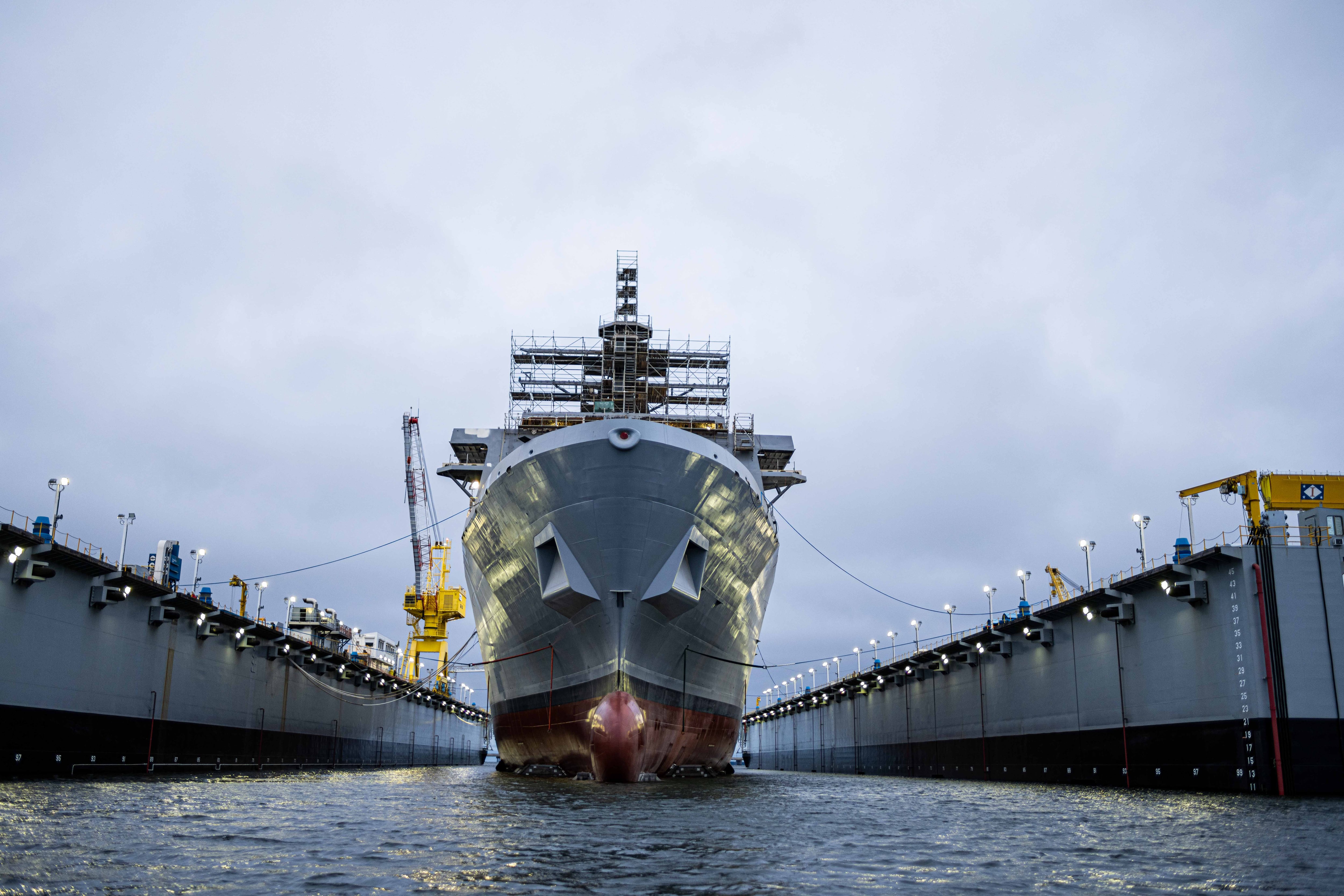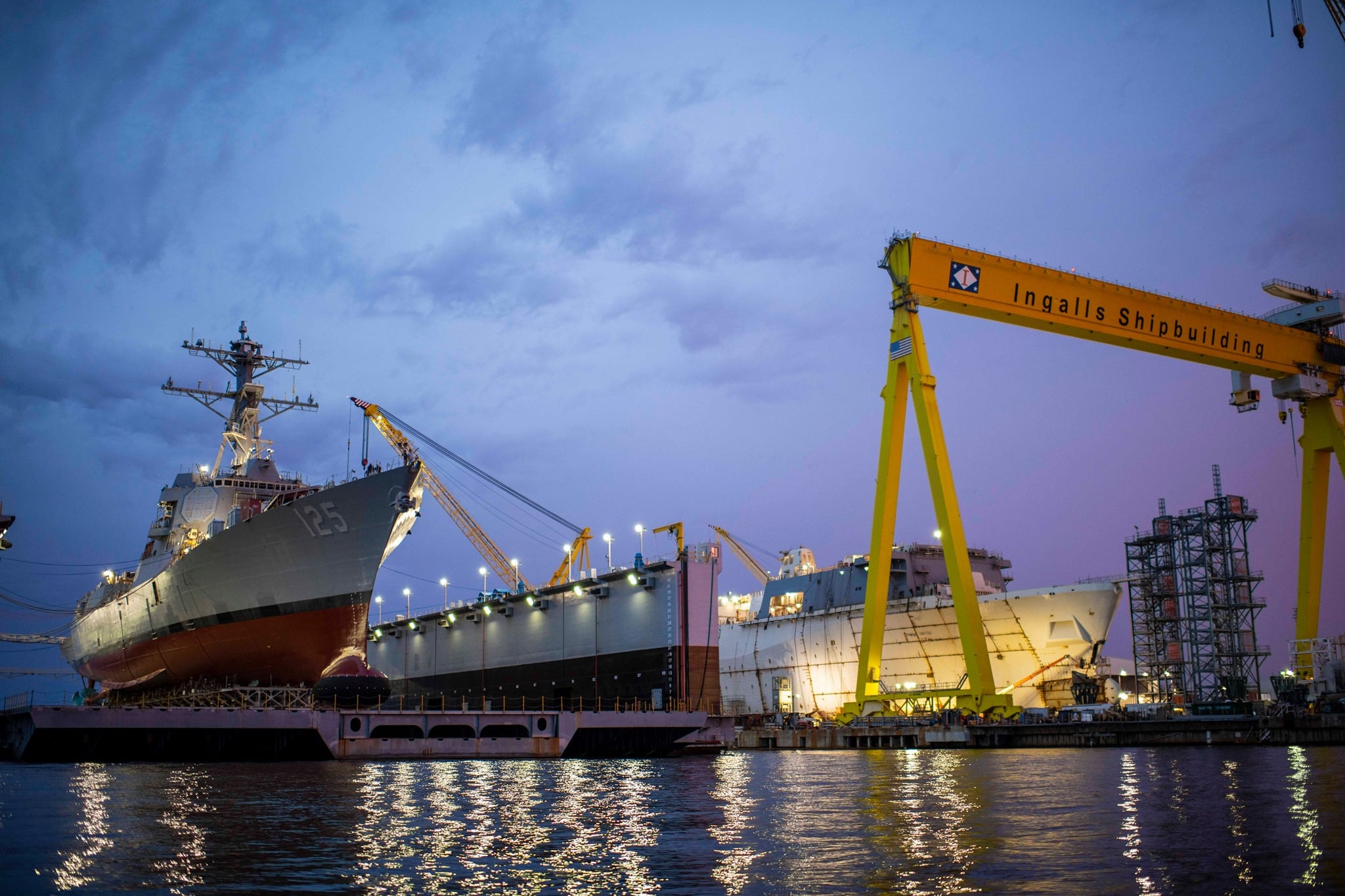WASHINGTON — The U.S. Navy doesn’t want to promise to buy too many ships in the next five years, in case it can’t follow through due to budget or supply chain constraints.
But its unwillingness to guarantee work to shipbuilders will cost the sea service millions of dollars in the long run, a top official told Defense News.
The Navy needs more Flight III Arleigh Burke-class destroyers, as the cruisers begin to exit the fleet and the Flight I DDGs near the end of their planned service lives. A number of lawmakers have said they’re open to funding three new destroyers a year compared to the expected two a year, something industry — the Ingalls Shipbuilding yard in Mississippi and the General Dynamics Bath Iron Works yard in Maine, plus their suppliers — would welcome.
But the Navy only has two a year in its near-term shipbuilding plans.
Moreover, it only plans to ask for nine guaranteed ships in its upcoming five-year procurement contract, which, if executed to that minimum level, would be a decrease in workload for the shipbuilders.
The legislative proposal the Navy will soon send Congress will ask for authority to buy nine ships, plus an option for a 10th ship to continue the two-a-year pace as well as additional options to buy a third ship each year if Congress appropriates additional funds, Jay Stefany, the principal civilian deputy to the assistant secretary of the Navy for research, development and acquisition, told House Armed Services seapower and projection forces subcommittee members in a May 18 hearing.
This request, he said, gives flexibility to scale up to the three-a-year procurement rate industry and some lawmakers want. It also allows the Navy to stay at nine ships if funding levels are lower than expected, if inflation crowds out the shipbuilding budget, if labor and supply challenges drive up the cost of ships or another contingency arises.
But Stefany said this flexibility comes at a cost. The savings in multi-ship contracts come from guaranteeing work. In this case, Bath Iron Works and Ingalls Shipbuilding can ask their suppliers for quotes on material and systems based on buying nine ship sets. They’d get a better price if they asked for a quote for 10 ship sets and an even better price if they asked for 15 ship sets upfront.
“A 10-ship multiyear will save us more than a nine-ship multiyear. That cost is not overly large, but that’s a decision that the department’s made of value versus flexibility,” Stefany told the subcommittee.
After the hearing, Stefany told Defense News his team was still working to compare the cost of a nine-ship versus a 10-ship contract. Generally, he said, “it’s in the millions, but it’s not a huge number.”
He noted the option ship for each year would essentially cost the Navy full price, rather than the 7% to 8% savings that come with economic order quantity savings.
The option ships “would be priced higher because they’re not guaranteed.”

Rep. Rob Wittman, the top Republican on the subcommittee, told Stefany during the hearing he doesn’t think the flexibility is worth the cost.
“Fewer ships, or being able to take out ships, is not the direction we should be going,” he said. In his opening remarks, which he submitted in writing after the hearing, Wittman, of Virginia, said “I reject the administration’s anemic shipbuilding request and will seek to expand our shipbuilding plans required to meet our warfighting requirements by accelerating construction of our destroyers, frigates and auxiliary ships.”
Rep. Jared Golden, a Democrat from Maine, criticized the Navy for “talking about a desire to see these two yards get to a place where they can do three ships per year,” but not taking firm steps to help them achieve that goal, such as committing to work so the yards can hire and train a sufficiently large workforce.
Broader shipbuilding instability
The Navy faces a similar situation with its guided-missile frigate program.
Stefany said in the hearing that Wisconsin-based Fincantieri Marinette Marine invested in increasing its capacity to build the Constellation-class frigate, but the Navy plans to buy them in a sawtooth pattern of one, then two, then one, then two each year in the near term.
Stefany called this the “minimum sustaining rate” to keep Fincantieri’s production line moving.
Vice Adm. Scott Conn, the deputy chief of naval operations for warfighting requirements and capabilities, said at the hearing the Navy would buy more if it could afford it.
“That profile is affordability, plain and simple,” he said.
“The initial ‘one’ is to de-risk the program: we need that ship on time and we don’t want to over-pressurize” the workforce as it’s learning to build the frigate and wringing out design issues, Conn said. “Once the contractor demonstrates that they are on plan, with resources available we would go to two across the board, or perhaps more in the future.”
The Navy faces the same problem with its amphibious warships, where it plans to truncate the San Antonio-class amphibious transport dock program and buy America-class amphibious assault ships LHA-9 and LHA-10 more than a decade apart, despite a four- or five-year cadence being most cost-effective.

Stefany confirmed during the hearing the Navy would pay more for LHA-10 due to the elongated build cycle.
Rep. Elaine Luria, D-Va., criticized the approach, telling Navy officials they “submitted a request that you admit is more expensive in the long run and essentially guts the workforce” at Ingalls Shipbuilding, the sole provider of amphibious ships.
George Nungesser, Ingalls’ vice president of program management, told reporters in a May 11 call the yard essentially views the LHA program as having a gap.
“Gaps — they cause concerns. You don’t know how to go plan for the future or how to hire, train or retain a skilled workforce,” he said.
“We’ve experienced this type of gap” when the Navy ended the Arleigh Burke production line in the 2000s but then later restarted it, leaving Ingalls with a five-year gap between ships. That meant essentially a new workforce constructing the DDGs, after much of the original skilled workforce moved on to other ship programs at Ingalls or other employers altogether.
“We know that impacts the supply base, things of that nature, and increases pricing, and so that’s why we’re trying to figure out how do we move to a four-year [gap between ships]” despite what the Navy’s long-range shipbuilding plan and five-year budget plan lays out.
The House Armed Services Committee will take up the annual defense authorization bill next month, which will shed more light on Congress’ plans for both the destroyer multi-year contract and the rest of the shipbuilding portfolio.
Megan Eckstein is the naval warfare reporter at Defense News. She has covered military news since 2009, with a focus on U.S. Navy and Marine Corps operations, acquisition programs and budgets. She has reported from four geographic fleets and is happiest when she’s filing stories from a ship. Megan is a University of Maryland alumna.





